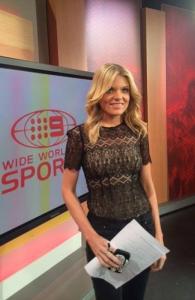In week eight’s tutorial we discussed the issue of gender and the state of the newsroom. It is common knowledge that there is a lack of female reporters in the news industry. This topic had significant relevance to me as I aspire to be a leading sports journalist, a field where males dominate.
With drawing particular focus to Rugby League journalism, as this is an area I am hoping to work in, there has been one female journalist who has made her mark on the industry, Erin Molan. Erin started making appearances on Channel Nine’s NRL Footy Show in 2013 before securing a co-hosting spot in 2014 and continuing on into 2015 (The Grill Team, 2014).

There were and still are mixed opinions of Erin’s major role on such a male dominated show as she shares the panel with ex players of the game, while she has no experience playing Rugby League. However producers of the show and Channel Nine have supported her every move.
Since becoming a well-known face on The Footy Show, Erin has scored herself many other opportunities including regular appearances on The Sunday Footy Show and radio segments.
Erin previously had a regular sports segment on Kiis FM with Kyle and Jackie O, which she quit after being asked whether she had breast implants and what sportsmen she has had sex with (News.com.au, 2014).
Hitting back with the statement:
“To every young woman out there and every person out there, you determine your worth and if you feel you’re ever in a situation where you are not being treated with respect or the way you are being treated is not acceptable to you then you have every right to walk away and every right to stand up for yourself,”
Erin earned respect from many of her critics and portrayed herself as a great role model for up and coming female journalists (News.com.au, 2014).
I believe this situation has highlighted a significant difference in how male and female journalists are treated. A male journalist would never be asked a personal question about his appearance, so why should a female journalist be asked about hers?
This brings me to another example, Channel Nine’s Today Show host Lisa Wilkins is constantly receiving comments on her outfit each morning while it has been exposed that Karl Stefanovic wore the same suit every day for a year but nobody noticed (Lallo, 2014). Is this acceptable? And why is there so much focus on Lisa’s outfit choice and not on the words that come out of her mouth?
The double standards in regards to appearance for journalists appears to be a reoccurring issue that needs to be dealt with.
References
Erin Molan quits Kiis Fm after inappropriate and sexist questions during her sports segment, 2014, News.com.au, viewed 11 May 2015, <http://www.news.com.au/entertainment/tv/erin-molan-quits-kiis-fm-after-inappropriate-and-sexist-questions-during-her-sports-segment/story-fnndfy6b-1227029489557>
Lallo, M 2014, ‘Karl Stefanovic’s sexism experiment: Today’s presenter wears same suit for a year’, Sydney Morning Herald, 15 November, viewed 11 May 2015, <http://www.smh.com.au/entertainment/tv-and-radio/karl-stefanovics-sexism-experiment-today-presenter-wears-same-suit-for-a-year-20141115-11ncdz.html>
The Grill Team, 2014, Erin Stands Her Ground, The Grill Team, weblog, 18 August, viewed 11 May 2015, <http://www.triplem.com.au/sydney/shows/grill-team/blog/2014/8/reports-erin-molan-from-nrl-footy-show-refused-to-return-to-sydney-radio-station/>

